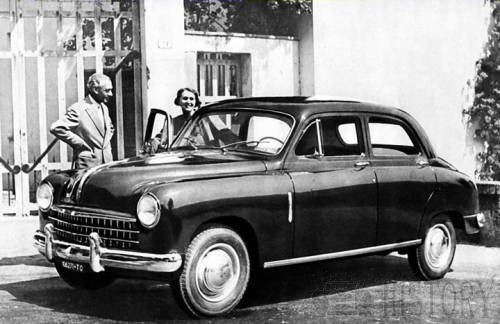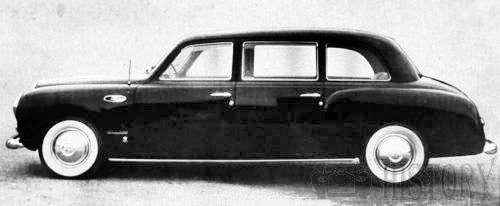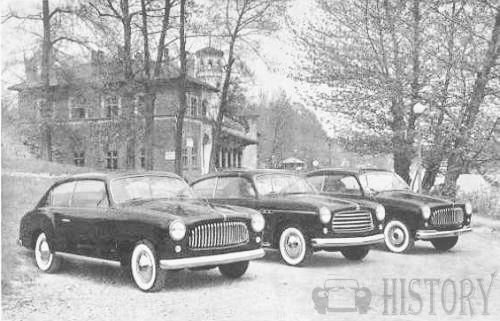Fiat 1400
| (1950-1958) | |
|---|---|
 | |
| Overview | |
| Manufacturer | Fiat |
| Also called | Zastava 1400 BJ |
| Production | 1950-1958 |
| Designer | Dante Giacosa |
| Body and chassis | |
| Body style | 4-door sedan 2-door cabriolet (1400) 2-door coupé (1900) |
| Layout | FR layout |
| Related | SEAT 1400 & Zastava 1400 BJ |
| Powertrain | |
| Engine | straight-4 |
| Transmission | 4 and 5-speed manual |
| Dimensions | |
| Wheelbase | 265 cm (104.3 in) |
| Length | 424 cm (166.9 in) |
| Width | 166 cm (65.4 in) |
| Height | 153 cm (60.2 in) |
| Curb weight | 1,150 kg (2,540 lb)-1,250 kg (2,760 lb) |
| Chronology | |
| Predecessor | Fiat 1500 |
| Successor | Fiat 1800/2100 |
The Fiat 1400 is a model of car produced by Italian automotive manufacturer Fiat between 1950 and 1958. The car was introduced at the 1950 Geneva Motor Show. It was the first chassisless Fiat automobile. In 1953 the introduction of a diesel version with a 1900 cc engine marked another Fiat first, although the diesel version was known as the 1400 Diesel.
Also in 1953 the Fiat 1400 became the first model to be produced by SEAT in Spain and the first model of passenger car produced by Crvena zastava in FNRY.
The Fiat 1900, introduced in 1952, was an upmarket model that used the same body as the 1400, but came with a 1.9 litre engine and more standard features. The petrol-engined Fiat 1900 A, introduced in 1954, now offered a claimed 70 bhp. It also featured a hydraulically operated clutch and, unusually for that time, a five speed column shifted manual transmission.

1951 Fiat 1400 Siata Limo
Features
- The engine had a 1,4 ltr capacity and a power output of 44 hp (33 kW) with 4400 rpm.
- The larger engine offered from 1952 had a 1,9 ltr capacity and a power output of 70 hp (52 kW) with 4400 rpm.
- It had a maximum speed of 120 km/h (75 mph) (1400 cc version).
- Unloaded weight of 1,120 kg (2,469 lb).
- Hand brake handle under instrument panel,
- Retaining loops for front seat passengers at the roof and at the backrests,
- Armrests in the doors
- Fuel filler access was through a trap door in the floor of the trunk/boot, thus keeping the fuel safe once the car was closed and locked
- The 1900 came standard with a radio and a rudimental "trip computer" that showed the average speed.
About 179.000 1400s and 19.000 1900s were built.
A 1400 cc model tested by the British magazine The Motor in 1950 had a top speed of 74.4 mph (119.7 km/h) and could accelerate from 0-60 mph (97 km/h) in 35.7 seconds. A fuel consumption of 24.2 miles per imperial gallon (11.7 L/100 km; 20.2 mpg-US) was recorded. The car was never sold in the UK, but the Italian market price would have equated to approximately £750 including taxes. Having eulogised the performance and "quite exceptional...top gear flexibility", British journalists went on to praise the "astonishing silence, smoothness and comfort provided by the vehicle", highlighting various "unique features designed to prevent the transmission of noise and vibration to the passengers". Great use was made of rubber and of "a sound-proofing compound...liberally coated...[on the car's]...integral structure".
The The Motor tested a 1901 cc diesel model in 1954 and recorded a top speed of 63.8 mph (102.7 km/h), acceleration from 0-60 mph (97 km/h) in 45.2 seconds and a fuel consumption of 33.9 miles per imperial gallon (8.3 L/100 km; 28.2 mpg-US). The car was not at the time available on the UK market but a price in Italy of 1,545,000 Lire was quoted which they worked out as equivalent to £909.
Models
| Model | Engine | Displacement | Power | Fuel system |
|---|---|---|---|---|
| 1400 | straight-4 ohv | 1395 cc | 44-56 hp | single carburetor |
| 1400 D | straight-4 ohv | 1901 cc | 40 hp | diesel |
| 1900 | straight-4 ohv | 1901 cc | 60-80 hp | single carburetor |
The 1951 fiat 1400 range




